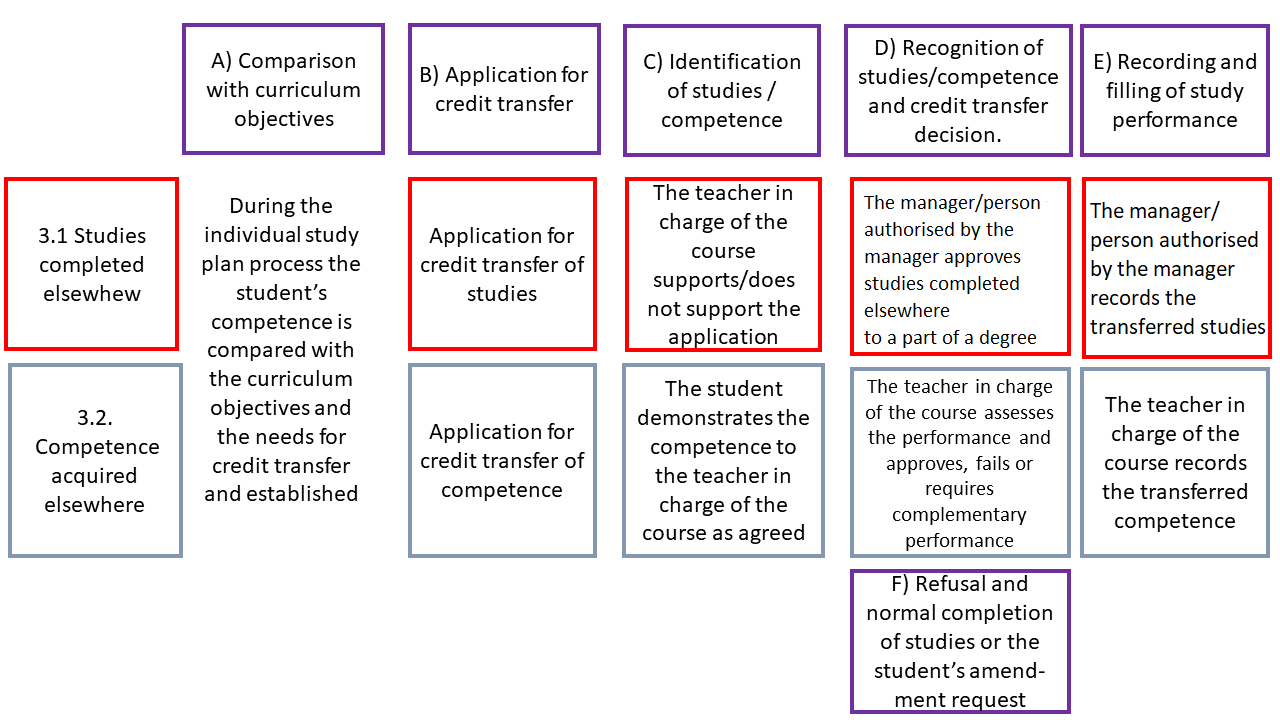Recognition of prior learning
Definitions
Credit transfer refers to the process during which studies the student has completed elsewhere (credit transfer for studies) or work experience or other competence (credit transfer for competence) are accepted to a part of the pursued degree or course, into compulsory, optional or free-choice studies.
Transferred studies or competence may compensate for curriculum studies or they may be included in the curriculum studies.
Compensation: studies are compensated with elsewhere completed studies of equivalent level and nature as regards the learning objectives.
Inclusion: inclusion of elsewhere completed studies in the degree.
Identification: understanding, analysis and demonstration of competence acquired in diverse manners in relation to the competence objectives of the degree.
Recognition: provision of official approval for your competence acquired in diverse manners.
These instructions on credit transfer for studies and competence may be specified with separate degree programme or option specific instructions.

Credit transfer for studies completed elsewhere
We may allow credit transfer for studies completed in Finnish or foreign higher education institutions or universities. Degree studies that form a general eligibility requirement for the education may not be transferred. In upgrading of qualifications (adult education), the vocational college diploma can be transferred to a part of the new degree.
Higher education studies are transferred according to the curriculum objectives of the student’s degree programme. The student usually gains credit transfer for studies completed in the same degree programme in another university of applied sciences. If the student has studied in another degree programme or has completed university studies, the aim is to transfer the studies as far as they correspond to the studies in the degree programme or competences required for the degree or are otherwise applicable to the degree. Some of TAMK's degree programmes may exceptionally have such separately defined studies that cannot be transferred with studies completed elsewhere. One can have information on these exceptions from the student counsellor or teacher tutor.
The transferred studies completed elsewhere are entered to the study register with their original grades.
The degree regulations section 28 on expiry of studies states that "The general expiry time for studies is ten years. The head of degree programme can decide on a different expiry time in a degree programme."
Credit transfer for studies completed in international exchange
TAMK follows the credit transfer system approved by the European Union and thus studies and practical training passed abroad are fully transferred to the pursued degree. Transferred studies and practical training are entered to the study register according to the following assessment scale: A = excellent (5), B = good (4), C = good (3), D = satisfactory (2), E = satisfactory (1), and FX = fail (0) or with the marking pass (S).
Outgoing exchange students have to fill in a written learning agreement form before departure. The learning agreement is approved by the head of degree programme on the international coordinator's proposal. After the studies abroad, the receiving higher education institution has to give a transcript of records and/or a certificate including the implementation of studies and study success.
Credit transfer can only be denied if the student does not attain the level required by the receiving higher education institution or fulfil the conditions set by the participating higher education institutions.
Credit transfer for international exchanges and practical trainings does not take place in Creta accreditation system but through international coordinators (long exchanges) and training supervisors (international practical trainings). The teacher in charge enters short study trips and exchanges to PAKKI.
Credit transfer for competence acquired elsewhere
Identification of elsewhere acquired competence refers to the measures enabling credit transfer for competence acquired by the student in diverse situations. The competence acquisition methods (e.g. studies, courses, work experience) affect which methods are reliable in demonstrating the competence. The most common competence demonstration methods are e.g. skills tests, portfolios, assignments, and examinations. By these means the student demonstrates that (s)he has attained the learning outcomes of the course. The student takes the initiative to credit transfer for competence.
The student has the right to apply for recognition of elsewhere acquired competence, regardless of where and how it has been acquired. The recognised competence has to conform to the learning outcomes of the degree programme courses. It is the student's responsibility to demonstrate and verify the competence and provide sufficient information.
The competence is identified and recognised by the teacher in charge of the studies. Assessment follows the same assessment criteria and scale as is followed in courses with corresponding learning outcomes.
The competence identification methods and amount of studies to be approved through competence tests are defined in each degree programme following TAMK's general definitions of policy. The decision on recognition of competence is as a rule made at the beginning of the studies or at the latest before the beginning of the study module. Some of TAMK's degree programmes may exceptionally have such separately defined studies that cannot be transferred. Students can have information on these exceptions from the student counsellor or teacher tutor.